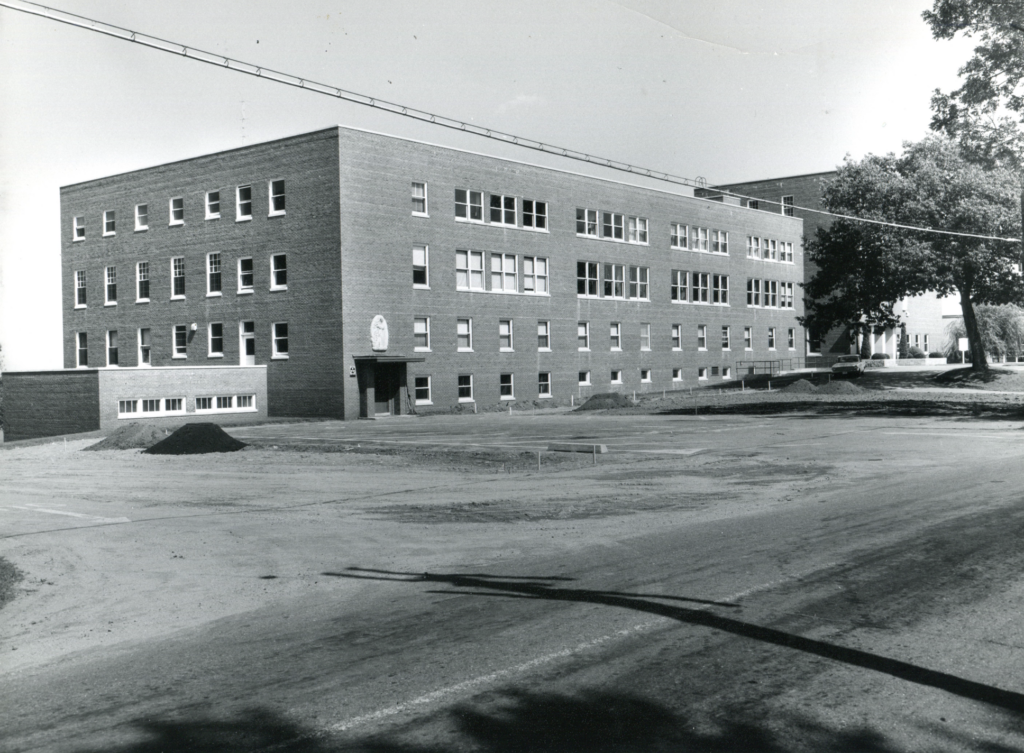In the past week, our team changed gears. We’re into the archives. Sifting through documentary evidence in an effort to nail down answers to as many of the questions that we have as possible.
We’ll report more about all of that in future posts.
While the students are getting their hands dirty in a different way than was true during the archaeological phase of the course, the instructors are plowing away on preparations for the oral history portion of the class. Who might we talk to and are they willing to share?
With emails flying, something rather surprising happened: we encountered a ghost.
Before getting to that, it is worth reflecting on the death of The Wayside in 1963. We do not have any photographs of the moment of death, when wrecking ball hit building. There are no receipts from the company that hauled away the rubble. There is only a photograph of the house site, freshly bulldozed, and the reality that the building simply is not there anymore.

A second photograph documents the presence of new plants, sod. A new look for a place that was home to multiple families, a dinner hall, and over a decade of students.

It was there. Then it wasn’t. Even the memories retreated into dark recesses.
Then I received an email back from one of the people I’d contacted about potentially talking to students… She’d grown up in the house in the 1970s. There are photographs.
The Wayside story does not end in 1963. Instead, it moves in two different directions which now we must try to track down.
The house was sold and split in half. Part of it became a single-family home. Life happened there. My source grew up.
That half of the house carried on until only a handful of years ago when it was ultimately torn down to make way for a more modern building.
The other part of the house, the garage (then classrooms and dorms) arrived at another location, not far from UNE. It appears that it was transformed into a masonry business, if not into one or two businesses before that. We’ll try to find out.
I took to Google Earth to find it, wondering if I might visit. I was not sure how to process what I saw on my screen. The dead had risen. It’s alive.

A few hours later, I drove the short distance to find the building. I knocked on the door of the associated house, met the couple who live there, and explained that I was very curious about their barn. No, no, I stressed. I’m not crazy. Just a history professor teaching a class. We’re all rather obsessed with the building. (Reading over that last line… Okay. Maybe I am a little crazy.)
In truth, I did not really need to explain. They welcomed me warmly and walked me back to the building.

As I stood there, I really did feel like I was looking a ghost in the face—so totally had I imagined the building was destroyed in 1963.

“Would you like to go inside?”
Definitely.
It’s being used for storage, and I won’t share interior photographs, but in my own mind I felt like I was stepping back in time. Standing in the upstairs, I could imagine it as the loft in a barn, but I could also picture beds, chairs, and St. Francis students visiting, studying, perhaps even holding the raucous parties that Robert Occhialini told us about seeing from the window of his dorm room in Decary. It wasn’t at all difficult to imagine.
Downstairs, the high ceilings said garage, but the space somehow screamed classrooms as well. Again, my imagination easily filled in details.
The visit complete, I thanked my hosts who welcomed the idea of students visiting. We’ll see about arranging that. They’ve only owned the property a few years, but suggested others we might talk to. I very much appreciate their hospitality and assistance. Thank you.
Driving away, I could not really express my feelings. I think that all of us involved in this course have become rather attached to this building as we’ve poked around the foundations and remaining rubble. We’ve imagined it as place. We’ve thought about the people who inhabited it and wondered at their stories. But we’ve always imagined a clear end point more than 60 years ago.
Today, of course the building would probably have been destroyed. Not so long ago, however, at a small Catholic school always short of money? Far better to sell it. To move it. To extend on the story.
This leaves only to say that evidence matters. We thought we had some, but in truth we had fragments that we filled-in with fiction. Such an approach simply won’t do. We must keep digging for reality.
— Prof. Eric G. E. Zuelow
